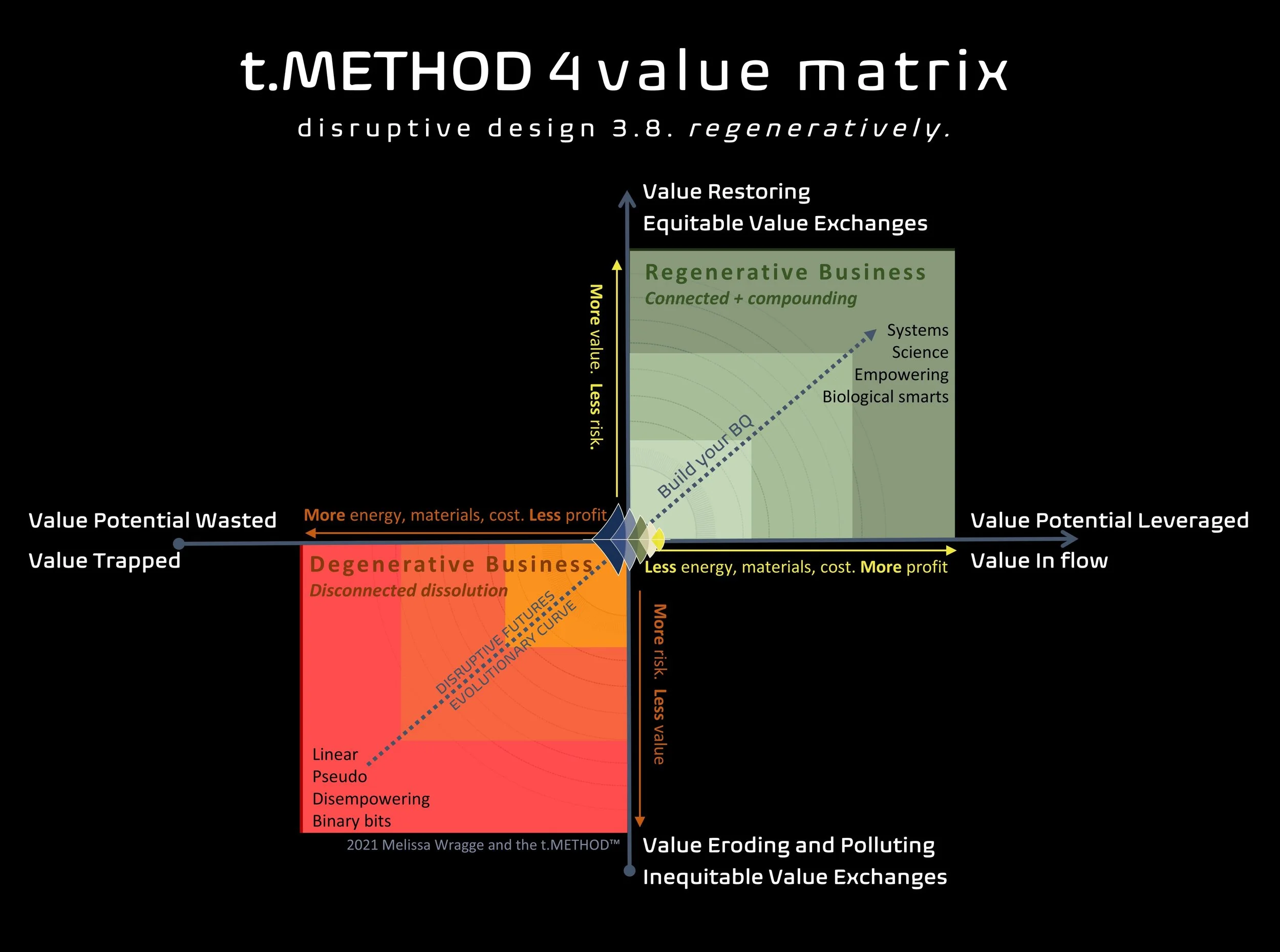
the insight
From researching 100 years of regenerative living-systems principles, and cross-calibrating with disruptive business re/design, Melissa gained key insights.
Here are the top three.
DESIGN THINKING VALUE AXES
1. Not one but four.
Design thinking is all about value. Creating, delivering and capturing value. Disruptive design is all about unlocking value potential. So how we define value really matters. But Nature unlocks value in very different ways. Nature works off not just one value axis, but four.
All four axes work together interdependently, in relationship. And all four individually and collectively drive towards regeneration. So if you want to play a disruptive regenerative game, you need to be able to sense, seize and scale value potential across all four axes.
Value flow. Value equitability. Value flourishing. Value potentiality.
This four-quadrant design thinking feeds directly into our bio.t™ compass, to build your BQ™. Your biological quotient. Helping you make better strategic decisions in a disruptive regenerative world.
DIAGNOSE . DISCOVER . DESIGN . DEPLOY.
LENS ON DISRUPTIVE DESIGN
2. The chasm of context.
When it comes to disruptive future thinking, and disruptive design, the lens of most strategy & innovation tools gravitate around the immateriality of market, competitor and digi tech trends. And separately, the lens of most Nature conversations gravitate around compliance, and TNFD disclosure reporting.
Customers might be king, but context is queen. Context is not an externality, it’s a strategic multiplier. So any business model re/design needs to be driven first from deeply understanding contextual conditions.
Nature’s adaptive fitness comes from fittedness to context. Nature’s ability to sense and seize opportunity is hardwired to context. Nature’s tech investment in processing speeds, networks and sensors is hardwired to context. Nature’s innovations and evolutionary prowess is hardwired to context.
We might be in the age of artificial intelligence, but at a meta scale, we’re in the age of living intelligence (we always have been). However, the re/connection between current strategy tools and the science of life has not yet been made. The materiality of the living world, and the lived experience is missing from business model re/design thinking. Which is ironic (or intentional), because this is where all the growth opportunity lies.
This insight has meant that each step in the bio.t™ canvas, and each part of the bio.t™ compass helps you up the pathway of contextualising you in the living world. So you are better placed to unlock your disruptive design potential.
VALUE LEVERS
3. The language of leverage.
Disruptive design is built on finding the levers to unlock value potential. Which means understanding leverage. But Nature does leverage very differently to how we’re taught in business school.
Most strategy & innovation tools advocate for a win-lose, zero-sum game of leverage. Based on things like extraction, exploitation, price arbitrage, restricted market access or data mining. This doesn’t just create inequalities, but a massive amount of material waste and energy entropy. It represents a massive loss of value and value potential.
Nature leverages differently. Nature doesn’t lean away from the tension of contextual constraints, but into the tension. Nature finds the levers in the tension. And leverages it (wind, gravity, fluid dynamics, electromagnetic forces, surface tension, symbiotic relationships etc). It’s inherently abundant.
This is why an abundant mindset is critical to transformation. And why re/connecting, in relationship is key, to access the genius of how life in Nature designs. As Buckminster Fuller said “Work with life centered principles & the universe pitches in to help.”
Every step in the bio.t™ canvas, and each part of the bio.t™ compass, explores deep biological patterns of leverage, based on re/connecting in relationship.
Why does this matter?
Because as global markets price in the materiality of the living world, there isn’t just huge risk. There’s huge opportunity.
But how you strategize, innovation, lead and transform needs to work from a different design thinking playbook. Because how you diagnose, discover, design and deploy value fundamentally changes. It’s not human centered design thinking, it’s Nature’s life-centered design thinking.
-
Most organizations are playing a Nature game driven by TNFD and SBTN governance disclosures. Considering their Nature footprint alongside their climate emissions.
But if we’re adopting a compliance cost mindset, and only tracking our negative impacts, or buying credits, or planting offset trees, we’re kinda missing the point.
RISK #1
As Aldous Huxley said, facts don’t cease to exist just because they are ignored. Despite political rhetoric, global markets are still rapidly pricing in the costs of Nature. So if we haven’t connected Nature to our strategy, innovations and business model, then the disruptive impact on our balance sheets and P&Ls will be big.
In orders of magnitude, the ‘natural capital’ bubble is 3xlarger than the CO2 bubble (Stuchtey et al 2016). Half of global business GDP, US$44 trillion, relies on Nature (WEF 2020).
Which means the negative impacts of being slow to change will hit not just our supply and operating costs, but our brand health, access to capital and markets, and growth potential.
RISK #2
The bigger risk of a Nature compliance mindset is we miss seeing the opportunity.
But there is a rapidly emerging global movement of disruptors, strategists, innovators, researchers, and design thinkers who are leaning into the tension and playing a bigger game.
-
The new, bigger Nature game is all about learning from Nature. To leverage Nature’s 3.8 billion years of evolutionary intelligence.
Why? Because Nature’s design thinking is not just regenerative, it plays at the highest order of functionality. High performance, high efficiency, low cost, low energy, high scalability.
This game connects your strategy, innovations and business model to the design thinking that underwrites the science of life.
You get to leverage the blueprints, hardcoding and working models Nature uses that have been tried, tested and proven to work, for a really long time.
Cutting-edge businesses playing this new game are reengineering anything from products, services and platforms to business models, value chains and organizational operations.
Many are not just disrupting the shape of global markets and global industries, they’re disrupting the rules of the global economy.
THE MAGNITUDE OF THE POTENTIAL
There is a 88%+ innovation gap between how biology designs and how humans design (Vincent and Mann 2011).
World Economic Forum estimates it could create US$10 trillion in GDP growth and 395 million new jobs by 2030.
“The 21st century will be the century of biology. The solutions to the biggest challenges we face are all deeply rooted in our understanding of life” - Craig Venter
“Biotech is transforming humanity’s potential, unlocking a new era, and reshaping what it means to live and create” - Jennifer Doudna
“Nature has already solved so many of the problems we’re grappling with.” - Janine Benyus
We are only at the beginning of our disruptive evolutionary journey.
-
We guide you on the journey to re/engineer your business. No matter where you are right now.
We work with you in three ways: Diagnostics. Capability building. Transformational journeying.
THE VALUE KEY
The key to unlock the biotech door of opportunity boils down to how you think about value. Because value is at the core of design thinking.
How to create, deliver, leverage and convert value
How to sense, seize, scale and transform value potential
4 VALUE AXES
We’ve learnt from our research that Nature works across not one, but four interdependent value axes i. Value flow (systems). ii. Value regeneration (ecology). iii. Equitable value exchanges (ethics), and iv. value potentiality (biomimicry).
So when it comes to re/designing your strategy, innovations or business model, how you think about value has to shift. To be a little more biological.
You don’t have to be a biologist, or even a design thinker, you just need to be open to new ways of seeing value, and value potential.
This builds your disruptive dynamic capabilities, and helps you avoid playing this year’s version of “faster, better, cheaper” that drives you toward competitive parity.
WHY WE WORK LIKE THIS
Because the rewards are big. When you use Nature's design thinking playbook, you open up the potential for multiples. 1. Multiple new revenue streams, 2. Multiple new market creating, 3.. Demand-led B2B and B2C growth, 4. Scalable growth, 5.. De-risking, 6. Lower costs, 7. Capital flows, 8. More profit, 9. And you play at the highest order of sustainability.
The beauty of Nature's playbook is that leverage does a 180° flip. Leverage becomes abundant. Not as a Pollyanna world view, but as a deep design principle. Which makes things way more fun.
(It’s why we call it the bright side).




